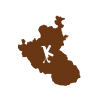Physical Geography of Kodagu
Physical Geography of Kodagu
Forests
The forests of Kodagu are divided naturally into deciduous and evergreen. The deciduous belt lies within 10 to 12 miles of the eastern boundary while finest evergreen trees are met within the south-west slopes and in the valleys of Western Ghats. The most valuable trees in the deciduous forest are teak, Honne,Betti, Nandi and Matthi.
The reserved forests are the deciduous belt in Nalkeri,40 square miles of Dubare, Maldare, Devamachi, Arekad, Attur, Malambee and Yedavanad 60 square miles. In these forests and the forests assigned to villages in North East Kodagu a good deal of sandalwood is found.
The next river of Kodavas importance is the Lashmanathreetha which rises in the Brahmagiri hills and flows through the Kiggatnad Taluk east ward into Mysore. The Hemavathi another Tributary of the Cauvery divides a small portion of Kodagu in the North east from manjarabad Mysore. The Barapole which rises in the Yedenalaknad Taluk, flows westward into the Malbar,where it is known as Irti. During the Monsoon months the rivers are full and are crossed by boats.


Comments
Leave a comment!Login for Post Comment
Last posts